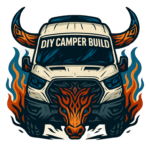If you’ve spent any time researching camper van heating options, you’ve probably come across those inexpensive Chinese diesel heaters — especially brands like Vevor or “no-name” Amazon kits.
They’re often priced at a fraction of a Webasto or Espar system, and they promise dry heat, low fuel use, and 12V compatibility. But are they actually any good?
Short answer?
Yes — if you install them properly.
Here’s everything you need to know before buying and installing a diesel heater in your camper van.
My Experience After Two Years
I’ve been running a Weber diesel heater in my van for almost two years now, and I’ve had zero major issues. It’s been reliable through Canadian winters, off-grid camping, and city stealth sessions.
But here’s the thing: it only works well because I took the time to install it safely and correctly.
Let’s talk about what that really means.
Why Diesel Heaters Are Worth It (When Done Right)
- Dry, consistent heat — unlike propane, diesel doesn’t create moisture
- Very fuel efficient — runs for hours on a few drops
- Can be used while driving
- Easy to power with a 12V setup
And best of all — they’re affordable. A full kit can cost as little as $150–$200. But you must upgrade some parts and be smart about safety.
Key Safety Measures You Shouldn’t Skip
1. Install a Smoke Alarm + CO2 Detector
This is non-negotiable.
Even though diesel heaters burn outside the cabin, leaks or malfunctions are still possible — especially if the unit isn’t sealed properly.
Mount the CO2 detector near your sleeping area, low to the floor.
2. Use High-Temp Silicone on Exhaust Ports
Most kits come with basic gaskets or nothing at all.
Use high-temperature RTV silicone where your exhaust pipe exits the van body — it’ll seal gaps and protect the metal from corrosion and fumes.
Pro tip: Use stainless hardware to mount the exhaust — it’ll last longer and resist rust.
3. Upgrade the Exhaust Tubing
The included flexible exhaust tube works, but it’s often thin and prone to cracking or leaks over time.
Replace it with:
- Thicker stainless exhaust pipe (ideally double-walled)
- High-quality clamps to prevent rattle and exhaust leaks
4. Secure the Fuel Line Properly
Avoid routing the fuel line too close to heat sources.
Use fuel-safe clamps and zip ties to keep it tucked and stable.
Also, always mount the fuel pump at an angle to avoid air bubbles — it makes a big difference in startup reliability.
5. Use Heavier Gauge Wire for Power
The wires in most kits are too thin, which can cause voltage drop and unreliable startups.
Swap them out for heavier gauge wiring, especially if you’re running longer cable distances to your power system.
Bonus: Add a dedicated fuse near your battery connection.
Other Small Upgrades That Go a Long Way
- Replace the fuel filter with a higher-quality inline one
- Add a silencer to the intake side to reduce noise
- Wrap the exhaust in heat-resistant wrap to protect nearby surfaces
- Add insulation tape around ducting to improve heat retention
Final Verdict: Are Chinese Diesel Heaters Worth It?
Absolutely — if you’re willing to put in that extra 10 to 20% effort to install it properly.
These heaters are one of the best value upgrades you can make in a DIY camper van. Brands like Vevor have proven themselves when installed correctly, and they’ll hold up season after season — as mine has.
And worst-case scenario?
Even if your heater gives out after a couple years, you can simply buy another full kit for under $200 and swap it in. You’ll still be way ahead compared to dropping $1,500–$3,000 on a Webasto or Espar setup.
And if you do decide to upgrade down the line, chances are:
- The exhaust hole you cut will still be usable or easily adapted
- Your overall layout and install experience will translate perfectly to a pro unit
- You’ll have a much better understanding of your heating system
Bottom line?
Start with the affordable option. Install it smart. Keep warm. And leave your options open.
Next Reads:
➡️ [“Vanlife Safety Tips: How to Sleep Securely in Your Van”]
➡️ [“Essential Tools and Supplies to Keep in Your Van at All Times”]
➡️ [“How to Fix Leaks in Your Camper Van (Even in the Rain)”]





